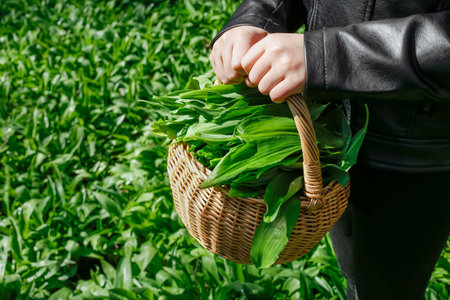Introduction to Wild Garlic
Wild garlic, known scientifically as Allium ursinum and fondly referred to as ramsons in the UK, is a native perennial plant that holds a cherished place in British woodlands. With its lush green leaves and distinctive garlicky aroma, wild garlic carpets the forest floor from early spring, creating a vivid and unmistakable display. Botanically, wild garlic is part of the allium family, closely related to onions, leeks, and chives. Its broad, lance-shaped leaves emerge before the delicate white star-shaped flowers appear, typically between March and May. In Britain, wild garlic has long been associated with ancient woodlands and shaded riverbanks, where its presence often signals a healthy, undisturbed ecosystem. For many in the UK, foraging for wild garlic marks the arrival of spring—a seasonal tradition that connects people to their local landscapes and culinary heritage.
2. Responsible Foraging Practices
Foraging for wild garlic in the UK is a rewarding and sustainable activity, but it comes with responsibilities to protect both nature and yourself. Understanding how to identify wild garlic, knowing the legal framework, and following ethical harvesting guidelines are essential steps to ensure this cherished plant continues to thrive.
How to Identify Wild Garlic
Wild garlic (Allium ursinum), also known as ramsons, is commonly found in damp woodlands across the UK from March to June. It has broad, green leaves and clusters of star-shaped white flowers. The most reliable identifier is its distinctive garlicky aroma when the leaves are crushed. However, caution is necessary as wild garlic can be confused with toxic plants like lily of the valley or autumn crocus.
| Feature | Wild Garlic | Lily of the Valley (Toxic) |
|---|---|---|
| Leaf Shape | Broad, lance-shaped | Narrower, more pointed |
| Scent | Strong garlic smell | No garlic scent |
| Flower | Star-shaped, white clusters | Bells, white hanging |
Legal Considerations in the UK
Foraging for personal use is generally permitted on public land where access rights exist, such as public footpaths and common land. However, it is illegal to dig up wild plants by their roots without the landowner’s permission under the Wildlife and Countryside Act 1981. Always respect private property and protected areas like nature reserves.
- Do not forage in Sites of Special Scientific Interest (SSSIs) or National Nature Reserves without explicit consent.
- If unsure about access rights, check with local authorities or landowners.
Sustainable Harvesting Tips
Sustainable foraging ensures future generations can enjoy wild garlic too. Follow these best practices:
- Only pick what you need—never strip an area bare; take no more than one third of any patch.
- Avoid uprooting the bulbs; harvest only leaves and flowers by pinching or snipping above ground level.
- Leave enough leaves on each plant so it can continue to photosynthesise and reproduce.
Avoiding Contamination
Forage away from busy roadsides or areas treated with pesticides to avoid pollutants. Wash your harvest thoroughly before consumption.
A Final Note on Respectful Foraging
Respect wildlife habitats and leave no trace—if you notice signs of over-picking or habitat damage, move elsewhere. Practising responsible foraging preserves wild garlic’s place in Britain’s countryside for everyone.

3. Traditional and Modern Culinary Uses
Wild garlic, or ramsons as its often called in the UK, has long held a cherished place in British kitchens. For centuries, its distinctively pungent leaves have been gathered from woodlands and hedgerows each spring, signalling the start of lighter, fresher meals after winter’s heavier fare. Traditionally, wild garlic features in classic British soups and broths—a staple comfort food for generations. A simple wild garlic soup, blending the leaves with potatoes, leeks, or cream, offers a nostalgic nod to rural traditions and foraged abundance.
Beyond soups, wild garlic finds its way into regional favourites such as Cornish pasties or cheese scones, where its gentle allium flavour provides a subtle twist without overpowering other ingredients. In Scotland and northern England, it is sometimes folded into oatcakes or mashed with new potatoes for a rustic accompaniment known as “champ.” These time-honoured recipes highlight wild garlic’s versatility and its ability to enhance everyday dishes with minimal fuss.
Today’s chefs and home cooks are embracing wild garlic’s potential in ever more inventive ways. One of the most popular modern adaptations is wild garlic pesto—a vibrant green sauce that swaps out basil for freshly picked leaves. Blended with British rapeseed oil, local hard cheese (such as Lincolnshire Poacher), and toasted hazelnuts or walnuts, this pesto brings a uniquely British flair to pasta, roasted vegetables, or even as a spread on sourdough.
Other contemporary uses include folding chopped wild garlic into risottos, omelettes, or savoury tarts. Adventurous cooks might infuse it into butter for slathering on grilled meats or fresh bread. Some London restaurants now feature wild garlic gnocchi or use the flowers as edible garnishes—demonstrating how this once-humble plant has found new life in modern British cuisine.
Whether you’re preparing a comforting soup reminiscent of childhood picnics or experimenting with wild garlic oil drizzled over seasonal asparagus, this versatile ingredient bridges Britain’s culinary heritage with today’s appetite for innovation.
4. Health Benefits and Nutritional Value
Wild garlic, or ramsons as its known across much of the UK, has long been cherished not just for its culinary uses but also for its nutritional and health-boosting properties. As interest in foraged foods continues to grow, it’s worth taking an honest look at what wild garlic offers in terms of vitamins, minerals, and potential health benefits—backed by both established studies and local wisdom passed down through generations.
Key Nutrients Found in Wild Garlic
Like its cultivated cousin, Allium sativum (common garlic), wild garlic (Allium ursinum) is packed with a variety of nutrients that support overall wellbeing. Here’s a breakdown of some of the main components found in this vibrant spring green:
| Nutrient | Role in the Body |
|---|---|
| Vitamin C | Supports immune function and acts as an antioxidant |
| Vitamin A | Essential for vision and skin health |
| Iron | Helps transport oxygen in the blood |
| Manganese | Involved in metabolism and bone health |
| Allicin (volatile compound) | Linked to antimicrobial and cardiovascular benefits |
| Folate | Vital for cell division and maternal health during pregnancy |
Potential Health Benefits According to Research
A number of studies have explored the medicinal qualities of wild garlic. The plant is well-known locally for its use as a traditional remedy for colds and digestive issues, but scientific investigations have begun to shed light on more specific effects:
- Cardiovascular Support: Several studies, including research published in the Journal of Agricultural and Food Chemistry, suggest that wild garlic may help reduce blood pressure and cholesterol levels due to its high content of allicin—a sulphur compound also found in common garlic.
- Antioxidant Properties: Wild garlic contains flavonoids and vitamin C, both of which act as antioxidants. These compounds help combat oxidative stress, potentially reducing the risk of chronic diseases.
- Antimicrobial Action: Traditional British herbalists have long used wild garlic as a natural antibiotic. Modern research supports its antibacterial activity, particularly against certain foodborne pathogens.
- Liver Support: There is emerging evidence that wild garlic may aid liver function by promoting detoxification processes within the body.
Cultural Perspective: Local Knowledge from Across the UK
Beyond scientific findings, many people across Britain hold wild garlic in high regard as a “spring tonic.” It’s often added to soups or stews for those feeling under the weather after winter. Folk remedies suggest that regular consumption can help stave off colds and improve vitality. While these claims are mostly anecdotal, they reflect generations of observation and experience with local flora.
A Balanced Viewpoint
While wild garlic boasts an impressive nutrient profile and a solid reputation among herbalists and researchers alike, it should be considered as part of a balanced diet rather than a cure-all. Its unique combination of vitamins, minerals, and bioactive compounds makes it a valuable seasonal addition to any kitchen—but as always, moderation is key.
5. Storing and Preserving Wild Garlic
Wild garlic, with its vibrant aroma and delicate flavour, is a quintessential British springtime find. However, its season is fleeting, making proper storage and preservation techniques essential if you wish to enjoy its culinary magic year-round. Here are some practical ways to keep wild garlic fresh after foraging, along with tips on drying, freezing, and pickling.
Keeping Wild Garlic Fresh
After picking, gently shake off any soil and give the leaves a light rinse under cold water. Pat them dry with a clean tea towel or kitchen paper. To maximise freshness, wrap the leaves loosely in damp kitchen paper and store them in an airtight container or resealable bag in the salad drawer of your fridge. This method should keep the wild garlic vibrant for up to a week.
Drying Wild Garlic
If you’d like to use wild garlic as a seasoning throughout the year, drying is a simple option. Spread the washed and thoroughly dried leaves out on baking parchment in a single layer. Place them in an airing cupboard or a warm, well-ventilated room away from direct sunlight. Alternatively, use a low oven (around 50°C) with the door slightly ajar. Once crisp, crumble the leaves and store them in an airtight jar for use in soups, breads, or sprinkled over roasted vegetables.
Freezing Wild Garlic
For preserving both the flavour and colour of wild garlic, freezing works wonderfully well. Chop the washed leaves and either freeze them flat in resealable bags or spoon into ice cube trays with a splash of water or olive oil. Once frozen solid, pop out the cubes and store in freezer bags for convenient portions – perfect for stirring into risottos or omelettes throughout the year.
Pickling Wild Garlic
Pickling is another traditional British method that lends itself beautifully to wild garlic buds and stems. Prepare a simple vinegar brine (equal parts white wine vinegar and water with a pinch of sugar and salt). Blanch the cleaned buds or stems briefly in boiling water, then pack them into sterilised jars and cover with hot brine. Seal tightly – after a fortnight, they’ll develop tangy notes ideal for salads or cheese boards.
Final Thoughts
With just a little care and forethought, you can savour the taste of wild garlic long after its short season has passed. Whether you prefer it fresh, dried, frozen, or pickled, these methods ensure you’ll have this wild delicacy on hand to elevate your dishes all year round.
6. Safety Considerations and Potential Pitfalls
Foraging for wild garlic in the UK is both rewarding and enjoyable, but safety must always be the top priority. While wild garlic (Allium ursinum) is generally safe to eat, it is crucial to avoid confusing it with potentially toxic lookalikes and to be aware of allergy concerns.
Key Reminders for Avoiding Misidentification
Wild garlic typically grows in damp woodlands and emits a distinct garlicky aroma when its leaves are crushed. However, several poisonous plants, such as lily of the valley (Convallaria majalis), autumn crocus (Colchicum autumnale), and lords-and-ladies (Arum maculatum), can grow in similar habitats and look deceptively similar, especially when young. Always use multiple identification points: check for the unmistakable smell, observe the leaf shape, and look at the location of growth. If you are ever unsure, err on the side of caution—never consume anything you cannot confidently identify.
Spotting Toxic Lookalikes
Lily of the valley has paired leaves with no garlic scent and produces bell-shaped white flowers, while lords-and-ladies have arrow-shaped leaves that lack any garlicky aroma. Autumn crocus displays glossy leaves that emerge early in spring but do not smell of garlic. Carry a reliable field guide or consult experienced foragers when in doubt.
Addressing Allergy Concerns
Although wild garlic allergies are rare, they can occur. Symptoms may include digestive discomfort or skin irritation after handling or consuming the plant. If you are new to eating wild garlic, start with a small amount to see how your body reacts. Those with existing onion or garlic allergies should exercise extra caution.
Responsible Foraging Practices
In addition to personal safety, remember that responsible foraging helps protect local ecosystems. Only take what you need and avoid uprooting entire plants so that wild garlic can continue to thrive in British woodlands.
By following these safety guidelines and respecting nature’s boundaries, UK foragers can enjoy wild garlic’s culinary and health benefits with confidence and peace of mind.

